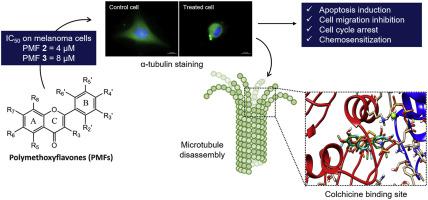当前位置:
X-MOL 学术
›
Chem. Biol. Interact.
›
论文详情
Our official English website, www.x-mol.net, welcomes your
feedback! (Note: you will need to create a separate account there.)
Polymethoxyflavones from Gardenia oudiepe (Rubiaceae) induce cytoskeleton disruption-mediated apoptosis and sensitize BRAF-mutated melanoma cells to chemotherapy.
Chemico-Biological Interactions ( IF 4.7 ) Pub Date : 2020-05-04 , DOI: 10.1016/j.cbi.2020.109109 Raimundo Gonçalves de Oliveira-Júnior 1 , Nolwenn Marcoult-Fréville 1 , Grégoire Prunier 1 , Laureen Beaugeard 1 , Edilson Beserra de Alencar Filho 2 , Eduard David Simões Mourão 2 , Sylvie Michel 3 , Lucindo José Quintans-Júnior 4 , Jackson Roberto Guedes da Silva Almeida 5 , Raphaël Grougnet 3 , Laurent Picot 1
Chemico-Biological Interactions ( IF 4.7 ) Pub Date : 2020-05-04 , DOI: 10.1016/j.cbi.2020.109109 Raimundo Gonçalves de Oliveira-Júnior 1 , Nolwenn Marcoult-Fréville 1 , Grégoire Prunier 1 , Laureen Beaugeard 1 , Edilson Beserra de Alencar Filho 2 , Eduard David Simões Mourão 2 , Sylvie Michel 3 , Lucindo José Quintans-Júnior 4 , Jackson Roberto Guedes da Silva Almeida 5 , Raphaël Grougnet 3 , Laurent Picot 1
Affiliation

|
A series of 10 natural and semisynthetic flavonoids (1 to 10) were obtained from Gardenia oudiepe (Rubiaceae), an endemic plant from New Caledonia. Most of them were polymethoxylated flavones (PMFs) of rare occurrence. After a cell viability screening test, PMFs 2 and 3 showed significant cytotoxic activity against A2058 human melanoma cells (IC50 = 3.92 and 8.18 μM, respectively) and were selected for in-depth pharmacological assays. Both compounds inhibited cell migration and induced apoptosis and cell cycle arrest after 72h of treatment. Immunofluorescence assays indicated that these outcomes were possibly related to the induction of cytoskeleton disruption associated to actin and tubulin depolymerization. These data were confirmed by molecular docking studies, which showed a good interaction between PMFs 2 and 3 and tubulin, particularly at the colchicine binding site. As A2058 are considered as chemoresistant to conventional chemotherapy, compounds 2 and 3 (½IC50) were associated to clinically-used antimelanoma drugs (vemurafenib and dacarbazine) and combined therapies efficacy was assessed by the MTT assay. PMFs 2 restored the sensitivity of A2058 cells to dacarbazine treatment (IC50 = 49.38 μM vs. >100 μM). Taken together, these data suggest that PMFs from G. oudiepe could be potential leaders for the design of new antimelanoma drugs.
中文翻译:

Garden子(芸香科)的聚甲氧基黄酮诱导细胞骨架破坏介导的凋亡,并使BRAF突变的黑素瘤细胞对化疗敏感。
一系列10种天然和半合成的类黄酮(1至10)从新喀里多尼亚的特有植物Garden子乌迪皮(Rubiaceae)获得。其中大多数是罕见的聚甲氧基黄酮(PMF)。经过细胞活力筛选测试后,PMF 2和3对A2058人黑素瘤细胞显示出显着的细胞毒活性(分别为IC50 = 3.92和8.18μM),并被选择用于深入的药理学检测。处理72小时后,两种化合物均抑制细胞迁移并诱导凋亡和细胞周期停滞。免疫荧光分析表明,这些结果可能与肌动蛋白和微管蛋白解聚相关的细胞骨架破坏的诱导有关。这些数据通过分子对接研究得到证实,该研究表明PMF 2和3与微管蛋白之间具有良好的相互作用,特别是在秋水仙碱结合位点。由于A2058被认为对常规化学疗法具有化学抗性,因此化合物2和3(1 / 2IC50)与临床使用的炭疽病药物(维罗非尼和达卡巴嗪)有关,并通过MTT分析评估了联合治疗的疗效。PMFs 2恢复了A2058细胞对达卡巴嗪处理的敏感性(IC50 = 49.38μMvs.> 100μM)。综上所述,这些数据表明,来自欧地氏假单胞菌的PMF可能是设计新的炭疽病药物的潜在领导人。PMFs 2恢复了A2058细胞对达卡巴嗪处理的敏感性(IC50 = 49.38μMvs.> 100μM)。综上所述,这些数据表明,来自欧地氏假单胞菌的PMF可能是设计新的炭疽病药物的潜在领导者。PMFs 2恢复了A2058细胞对达卡巴嗪处理的敏感性(IC50 = 49.38μMvs.> 100μM)。综上所述,这些数据表明,来自欧地氏假单胞菌的PMF可能是设计新的炭疽病药物的潜在领导者。
更新日期:2020-05-04
中文翻译:

Garden子(芸香科)的聚甲氧基黄酮诱导细胞骨架破坏介导的凋亡,并使BRAF突变的黑素瘤细胞对化疗敏感。
一系列10种天然和半合成的类黄酮(1至10)从新喀里多尼亚的特有植物Garden子乌迪皮(Rubiaceae)获得。其中大多数是罕见的聚甲氧基黄酮(PMF)。经过细胞活力筛选测试后,PMF 2和3对A2058人黑素瘤细胞显示出显着的细胞毒活性(分别为IC50 = 3.92和8.18μM),并被选择用于深入的药理学检测。处理72小时后,两种化合物均抑制细胞迁移并诱导凋亡和细胞周期停滞。免疫荧光分析表明,这些结果可能与肌动蛋白和微管蛋白解聚相关的细胞骨架破坏的诱导有关。这些数据通过分子对接研究得到证实,该研究表明PMF 2和3与微管蛋白之间具有良好的相互作用,特别是在秋水仙碱结合位点。由于A2058被认为对常规化学疗法具有化学抗性,因此化合物2和3(1 / 2IC50)与临床使用的炭疽病药物(维罗非尼和达卡巴嗪)有关,并通过MTT分析评估了联合治疗的疗效。PMFs 2恢复了A2058细胞对达卡巴嗪处理的敏感性(IC50 = 49.38μMvs.> 100μM)。综上所述,这些数据表明,来自欧地氏假单胞菌的PMF可能是设计新的炭疽病药物的潜在领导人。PMFs 2恢复了A2058细胞对达卡巴嗪处理的敏感性(IC50 = 49.38μMvs.> 100μM)。综上所述,这些数据表明,来自欧地氏假单胞菌的PMF可能是设计新的炭疽病药物的潜在领导者。PMFs 2恢复了A2058细胞对达卡巴嗪处理的敏感性(IC50 = 49.38μMvs.> 100μM)。综上所述,这些数据表明,来自欧地氏假单胞菌的PMF可能是设计新的炭疽病药物的潜在领导者。











































 京公网安备 11010802027423号
京公网安备 11010802027423号